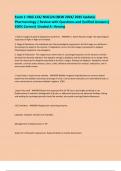Exam 1: NSG 124/ NSG124 (NEW 2024/ 2025 Update)
Pharmacology | Review with Questions and Verified Answers|
100% Correct| Graded A- Herzing
.3 distinct stages of general adaptation syndrome: - ANSWER-1. Alarm Reaction Stage- the physiological
responses of fight or flight are initiated.
2. Stage of Resistance- the individual uses the physiological responses to the first stage as a defense in
the attempt to adapt to the stressor. If adaptation occurs, the third stage is prevented or delayed.
Physiological symptoms may disappear.
3. Stage of Exhaustion- This stage occurs when there is a prolonged exposure to the stressor to which
the body has become adjusted. The adaptive energy is depleted, and the individual can no longer draw
from the resources for adaption described in the first 2 stages. Diseases of adaption- headache, mental
disorder, coronary artery disease, ulcers, colitis. Without intervention for reversal, exhaustion, and in
some cases death ensues.
.3-way Foley or triple lumen catheter - ANSWER-Bladder irrigation typically done to remove clotted
blood from the bladder and ensure drainage of urine. Can be done manually on an intermittent basis or
more commonly as continuous bladder irrigation. (CBI).
.3way Foley stuff - ANSWER-Blood clots expected first 24-36 hours, but bright red blood is not.
Displacement of catheter, dislodgment of lg clot, or abdominal pressure are abnormal findings. Sitting
and walking for prolonged periods should be avoided, also avoid straining/Valsalva Maneuver.
.ACE inhibitors - ANSWER-Angiotensin-converting enzyme.
captopril, enalapril, lisinopril are examples.
Management of Hypertension or HF.
Watch for orthostatic hypotension. Reduced libido or erectile dysfunction.
,Aspirin and NSAIDs may reduce drug effectiveness. Addition of diuretic enhances drug effect. Should not
be used with potassium sparing diuretics. Can cause increase in serum creatinine.
.Acute thyrotoxicosis (thyroid storm) - ANSWER-All symptoms of hyperthyroidism prominent/severe.
Manifestation include severe tachycardia, heart failure, shock, hyperthermia [up to 106], agitation,
delirium, seizures, abdominal pain, vomiting, diarrhea, and coma.
.airborne isolation - ANSWER-Negative air pressure and airflow of 6 to 12 exchanges per hour. HEPA
mask when entering room.
.ALS or Lou Gegrig's desease - ANSWER-This is a rare and progressive neurologic disorder characterized
by loss of motor neurons. Death in 2 to 6 years after diagnosis. Limb weakness dysarthria dysphasia.
.Ascites Treatment - ANSWER-Is to administer Albumin, it pulls fluids back to the vascular space. Low
sodium diet, diuretics, or paracentesis.
.Assessment of head/neck r/t thyroid - ANSWER-Inspect size/contour of head. Facial features should be
symmetric. Chvostek's sign may be present in hypoparathyroidism. Inspect eyes for position, symmetry,
and shape. Large/protruding eyes associated with hyperthyroidism. Assess visual acuity (Snellen)...
visual loss may indicate pituitary tumor.
Neck: thyroid is distinguished by upward movement during swallowing. Neck should appear symmetric
without lumps or bulging. Perform palpation. Auscultate lateral loves to identify a bruit, may indicate
goiter or hyperthyroidism.
.Assessment of Urinary System - ANSWER-Past Health History: Hypertension, Diabetes, gout and other
metabolic problems, connective tissue disorders (ex. Lupus), skin, upper respiratory infections, viral
hepatitis, congenital disorders, neurological disorders or trauma. Note all medications, some can be
"Nephrotoxic".
Subjective: painful urination? Changes in color of urine? Changes in characteristics of urination
(diminished, excessive)? Nocturnal?
Diagnostic: BUN/Creatinine. Urinalysis. Urine Culture and Sensitivity.
, Objective: Inspect Abdomen. Urinary meatus for inflammation or discharge.
Palpate: abdomen for bladder distention, masses, or tenderness.
Percuss: costovertebral angle for tenderness.
Female Urethra 1-2 inches long
Male 8-10 inches long
Kidneys sit from T12 to L3. Right kidney at 12th rib, slightly lower.
.Bacterial meningitis - ANSWER-Fever, severe headache, nausea, vomiting, stiff neck, positive Kernig's
sign, positive Brodzinski sign, photophobia, decreased LOC, signs of increased ICP, coma, seizures.
.BMi chart - ANSWER->18.5 underweight
18.5-24.9 NORMAL
25-29.9 overweight
>30 OBESE
.Calcium (Ca) - ANSWER-8.2-10.2 mg/dL
.Care for patient with pneumonia - ANSWER-Pneumococcal vaccine used to prevent Steptococcus
pneumoniae. Antibiotics are highly affective for both bacterial & mycoplasma pneumonia.
Uncomplicated cases, patients typically respond within 48-72 hours.
Supportive measures may also be needed per the individual patient: O2 therapy, analgesics (chest pain),
antipyretics.




